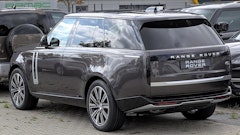
REBAR REVENGE
Have you ever removed a rebar rod from a body? A Prince Edward Island shop had quite the project after a local event volunteer turned up with a rebar rod lodged in his vehicle’s trunk. The poor volunteer had been working since 4 a.m. and returned to their vehicle to find a metal pole, originally used to prop up temporary fencing, embedded deep into his vehicle’s trunk.

The volunteer blamed the lack of security on site for the alleged vandalism—which he says was committed by inebriated festival go-ers.
SEEING SEDANS
Bodywork meets arts and crafts with the University of Tokyo’s latest project: a pair of motorized eyes for autonomous vehicles (AVs), intended to alert pedestrians to whether they’ve been seen by the vehicle. Unlike today’s vehicles, future AVs may not have human drivers, and require the ability to telegraph “driver” intent to pedestrians. Researchers created scenarios in a virtual reality environment, where nine male and nine female pedestrians decide whether it was safe to cross the road. In half the tests, the AV would wait for the pedestrian, while the other half drove through. Half featured googly eyes; half without.

It was found that the googly eyes helped male pedestrians make fewer dangerous road crossings, while fewer female pedestrians chose to wait for a car intending to stop. In both cases, the googly eyes resulted in smoother and safer crossings for pedestrians and vehicles alike.
BROKEN PHYSICS
Officers from the Ontario Provincial Police (OPP) experienced a glitch in the matrix this fall after members of the force responded to calls reporting a floating car. Thankfully, the scene was not part of a ritual gone wrong—just a car stuck on a wire.

“The inexperienced driver was not practicing magic tricks,” wrote the Highway Safety
Division. “They got caught up on a wire after making a poor turn.”
TECHY TAPWATER
Two hydrogen fuel cell electric buses were on display at the Edmonton Electric and Hydrogen Vehicle Expo from Sept. 24 to 25, where one official decided to prove how clean the tech is by drinking straight from a bus tailpipe. The two buses—Xcelsior models manufactured by New Flyer—use a Ballard fuel cell electric engine, which releases water and heat instead of greenhouse gas emissions. The verdict? It quenches.

These buses are part of Alberta’s $9.8 million Zero Emissions Hydrogen Transit initiative to cut greenhouse gas emissions. Edmonton’s energy transition strategy aims to cut emissions by 35 percent, compared to levels recorded in 2005. The province looks to achieve this by 2025 and cut a further 50 percent by 2030, striving for zeroemissions by 2035.




















